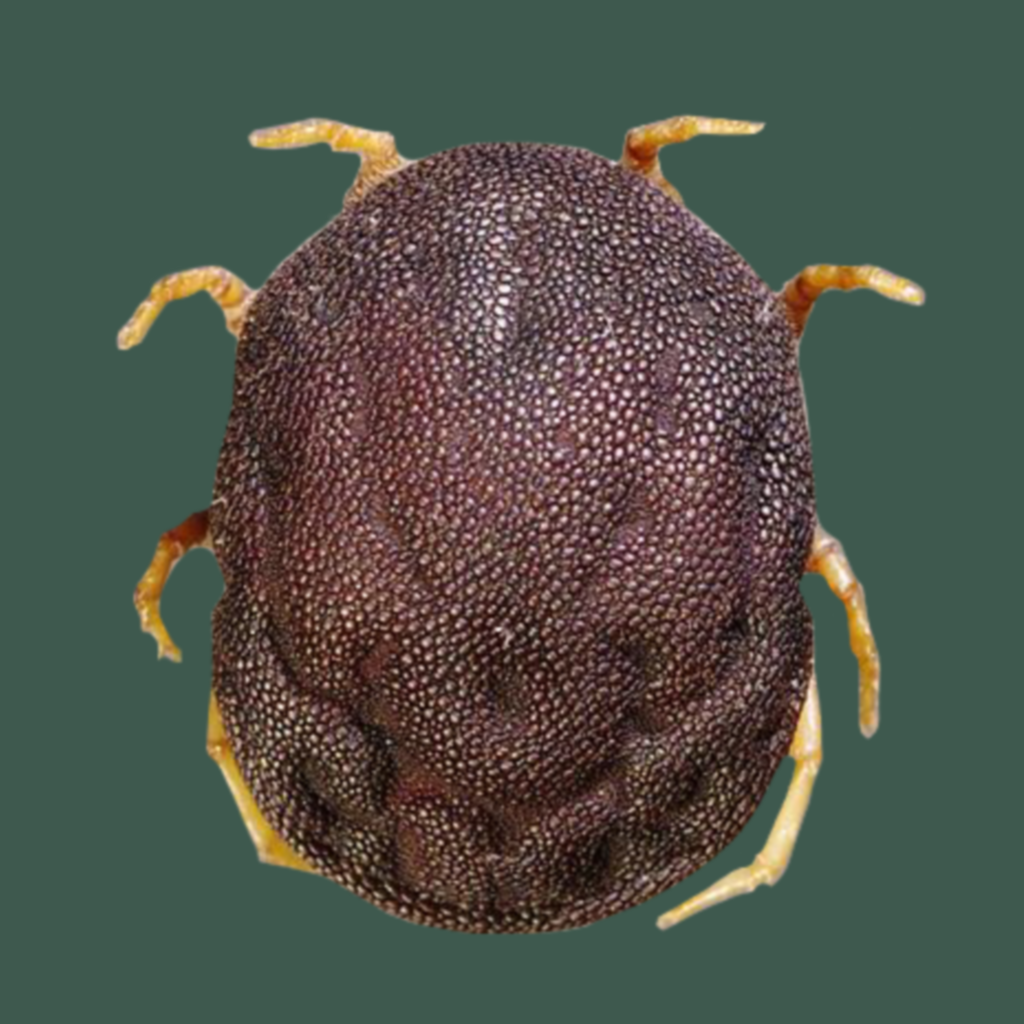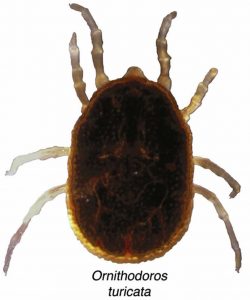SOFT TICK
Ornithodoros hermsi
The soft tick (Argasidae) identified below pose health risks for humans and animals in the Pacific Southwest. Soft ticks are recognized by their mouth parts being on the underside of the body. Unlike hard ticks, soft ticks do not have a hard outer shell (scutum).

Ornithodoros hersmi can be found throughout the western half of the United States, including Texas. This tick species prefer coniferous forests at altitudes of 1500 to 8000 feet where it feeds on tree squirrels and chipmunks. O. hermsi and other soft tick species live in dark, cool places such as rodent nests, shaded wood piles outside buildings, and between walls or beneath floorboards inside buildings. It is unlikely to encounter them outdoors in natural vegetation.
O. hermsi can carry and spread Borrelia hermsii bacteria (pathogen) that is responsible for the disease, Tick-borne relapsing fever (TBRF). O. hermsi is responsible for most TBRF cases in the United States.
Tick-borne relapsing fever (TBRF) is a rare infection linked to sleeping in rustic cabins, particularly cabins in mountainous areas of the western United States. The main symptoms of TBRF are high fever (e.g., 103° F), headache, muscle and joint aches. Symptoms can reoccur, producing a telltale pattern of fever lasting roughly 3 days, followed by 7 days without fever, followed by another 3 days of fever. Without antibiotic treatment, this process can repeat several times.
Avoid sleeping in rodent-infested buildings whenever possible. Although rodent nests may not be visible, other evidence of rodent activity (e.g., droppings) are a sign that a building may be infested.
- Prevent tick bites.
- Use insect repellent containing DEET (on skin or clothing) or permethrin (applied to clothing or equipment).
- If you are sleeping in a cabin, move beds away from walls and keep bed covers from touching the floor.
- If you are renting a cabin and notice a rodent infestation, contact the owner to alert them.
- If you own a cabin, consult a licensed pest control professional who can safely:
- Identify and remove any rodent nests from walls, attics, crawl spaces, and floors. (Other diseases can be transmitted by rodent droppings—leave this job to a professional!)
- Treat “cracks and crevices” in the walls with pesticide.
- Establish a pest control plan to keep rodents out.
Other species of soft ticks associated with TBRF are:
- Ornithodoros parkeri
- Occurs at lower altitudes, where they inhabit caves and the burrows of ground squirrels and prairie dogs, as well as those of burrowing owls.
- O. parkeri can carry and spread Borrelia parkerii (pathogen) which causes TBRF (disease)
- Ornithodoros turicata

- Occurs in caves and ground squirrel or prairie dog burrows in the plains regions of the Southwest, feeding off these animals and occasionally burrowing owls or other burrow- or cave-dwelling animals.
- O. turicata can carry and spread Borrelia turicatae (pathogen) which causes TBRF (disease)
 California Department of Public Health (CDPH):
California Department of Public Health (CDPH):

Centers for Disease and Control Prevention (CDC):
TICK RESOURCES
Learn about the tick species that pose health risks for both humans and animals in the region and view public health information on ticks.
GOT TICKS? CONTACT BiTeRS!
The Border Tick and Rickettsia Surveillance (BiTeRS) program of PacVec offers services to enhance surveillance for ticks and tick-borne pathogens of human health concern in California and Arizona.
The Pacific Southwest Regional Center of Excellence in Vector-Borne Diseases is supported through Cooperative Agreement Number 1U01CK000649 between the Centers for Disease Control and Prevention (CDC) and the University of California, Davis.
© 2024 – All rights reserved